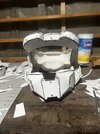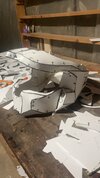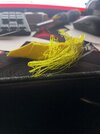Thee BurNs
New Member
Hi everyone, I’ve started doing a helmet, I’ve watched tons of videos to get a bunch of tips before starting anything. So far I’m enjoying building but would like some tips moving forward to either be able to fix some mistakes I’ve made or to prevent any mistakes in the next steps. I did notice that the front mouth portion is slightly tilted to the left if it’s possible for me to fix this or maybe just cut it slightly (there’s also a slight issue on the top portion but it doesn’t bother me that much … as of now). I don’t want to mess it up completely trying to fix it overall this is a learning experience for me and if it turns out good then I’ll take it as a bonus but anything helps on this build and future builds thank you!





